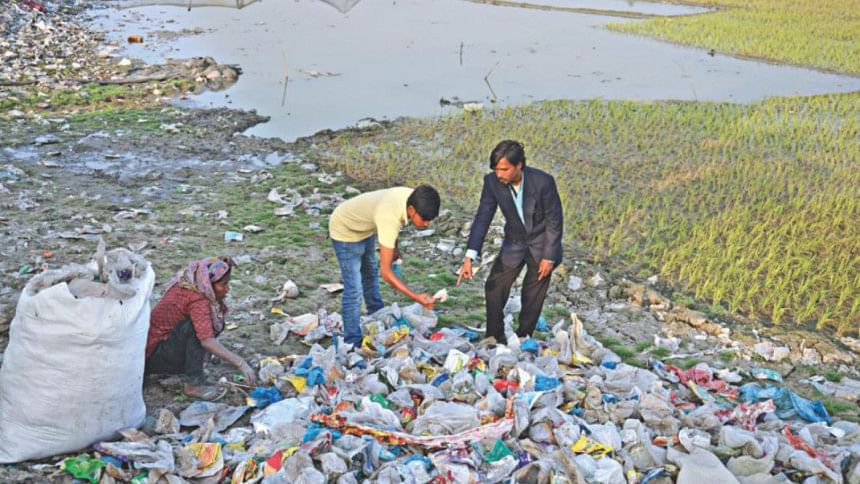Addressing the problem of trash and plastic waste

Our attitude to garbage disposal and plastic waste is flagrantly callous. What is particularly eye-soring is the mass of plastic waste of all types, ubiquitously filling up unending stretches of areas beside roads, railway lines, all conceivable nooks and crannies between buildings/shanties and, most egregious of all, as flotsam floating listlessly on all types of water bodies that have still managed to escape attention of insatiable land-developers. To be fair, this is not unique to our metropolis Dhaka or indeed to Bangladesh alone.
Humans produce nearly 300 million metric tons of plastic every year, 50 percent of which is for single use. Well over 8 million metric tons of this plastic waste, generated globally, end up in our oceans annually, of which around 236,000 metric tons are microplastics. Microplastics fragment further into nano-plastics that get easily mixed with normal food of marine life and get ingested by them—so ultimately, they travel back into the human food chain with deleterious consequences for human well-being.
It is estimated that over the last 10 years we have produced more plastic than during the whole of the last century. The UN Joint Group of Experts on the Scientific Aspects of Marine Pollution (GESAMP) estimates that land-based sources account for 80 percent of the world's marine pollution, of which between 60-90 percent comprises plastic debris. This waste accumulates over time at the centre of the vortices of ocean currents, forming huge garbage patches of floating debris. There are five such patches in the oceans, the largest in the Pacific having a size similar to the state of Texas. Plastics in the ocean have been found as far as 11km deep. Plastics will not biodegrade for long (estimates range from 450 years to almost never).
So what can we do to address this problem of general waste management and plastic waste management? A number of countries are already doing so, with great ingenuity and remarkably effectively, incinerating waste to produce power and using plastic waste to build roads. Bangladesh needs to look at those examples and consider how to adapt them to local circumstances and needs.
Foremost in waste management, notably, is Sweden which burns over half of its household waste to produce energy. In fact, because its waste disposal culture has so reduced domestic "raw material" for fuelling this industry, it is now even importing household waste from other countries (2.7 million tons in 2014, 2.3 million tons in 2015), to keep fuelling its 32 waste-fired power plants the first of which was set up in 1904.The incinerated waste is reduced to ashes comprising 15 percent of original weight, from which in turn metals are separated for use in other industrial applications while stuff like porcelain and tile, and the like which do not burn, are sifted to extract gravel that is used in road construction. The smoke from the incineration plants reportedly comprises 99.9 percent non-toxic carbon dioxide and water that can be filtered and also re-cycled.
A growing number of countries, notably India, the UK and Netherlands, are using plastic waste for road building. Enfield Council of the city of London is testing road resurfacing using asphalt made from recycled plastics. The asphalt mix is made up of pelletised plastic waste as a binder with the road mixture replacing the 10 percent fossil-fuel based bitumen that has for long been in use. It is claimed that this is an environmentally-friendly alternative, as well as stronger and longer-lasting.
In Netherlands, a Dutch construction company has developed a technique that results in what they claim is a virtually maintenance-free product that is unaffected by corrosion and the weather. Roads constructed using this material would be capable of handling temperatures ranging from -40°F to 176°F, and will also overcome the perennial problem of attrition to road surfaces and integrity caused by high rainfall. Any type of recycled plastic can be used for the purpose. Converting to plastic roads will reduce substantially the huge carbon footprint globally from use of asphalt, which currently accounts for around 1.6 million tons of carbon dioxide.
Similarly, a technique developed indigenously by "Plastic Man" of India, Professor Rajagopalan Vasudevan of Thiagrajan College of Engineering in Madurai, Chennai is now increasingly in test-use and has proven remarkably successful. Roads so constructed, initially within campus areas, have proved to be remarkably durable and weather-proof. Impressed by this success, the Government of India has made it mandatory for all road developers in the country to use plastic waste along with decreased bituminous mixes.
Can we think of replicating the "waste-2-power" model a la Sweden? We generate sufficient waste, nationally, to do so. If the model succeeds, we can rely on enormous quantities of endless waste that will continue to be produced for quite some time in our own national confines as well as immediate and extended neighbourhood to keep fuelling this project. A pilot project can be commenced with a limited defined area of Bangladesh to begin with. The power produced may be sold for use in the national grid or for designated industrial-economic development projects. Initial financial and technical assistance may also be sought from the Swedish government and its SIDA, and international development assistance donors. Private sector participation by industrial houses may also be sought. Government could be an active partner by creating the enabling environment and regulatory framework for embarking on this venture.
Roads built with conventional technique used for the last few centuries with bituminised asphalt and gravel wash out with the first rainfall every monsoon. So "resurfacing" the same stretches of roads frequently has become an agonisingly regular feature. We may also embark on pilot venture partnership projects using or adapting the Indian-UK-Norwegian "plastics-2-roads" model. Universities, whether public or private, and industrial enterprises/parks can perhaps first try it within their own geospatial confines, then expand it to identified highways (converting them into "toll ways" to recoup initial investment on BOT basis in agreement with national or local authorities).
Of course, both above types of projects would, ab initio, also have to devise a system of trash (including plastic trash) collection, from defined local areas, expanding it progressively. In the cities, locality cells of rag-pickers or tokais can be organised and mobilised for collection of all trash. These organised units may be also be tasked with sifting and separating the plastics from other garbage. In non-metropolitan areas, clustering contiguously located villages may be formed, and the local unemployed denizens, men and women, as well as children in their off time, can be incentivised to collect plastic trash during spare time and take them into defined repositories for suitable compensation. A competition may be instituted among villages within the cluster, as well as between clusters, with suitable prizes for best performers. This will create additional income during their spare time for those already employed, some employment for those unemployed, and valued pocket-money for children to augment their family income. Over a period of time it will also induce a measure of much-needed behavioural change.
The Cornucopian belief is that man's ingenuity and sheer grit and determination can find solutions to all problems that challenge his existence. We have an opportunity, now, to prove that this optimism is not misplaced.
Tariq Karim, a former career diplomat and academic, is currently Visiting Fellow at BRAC University.





Comments